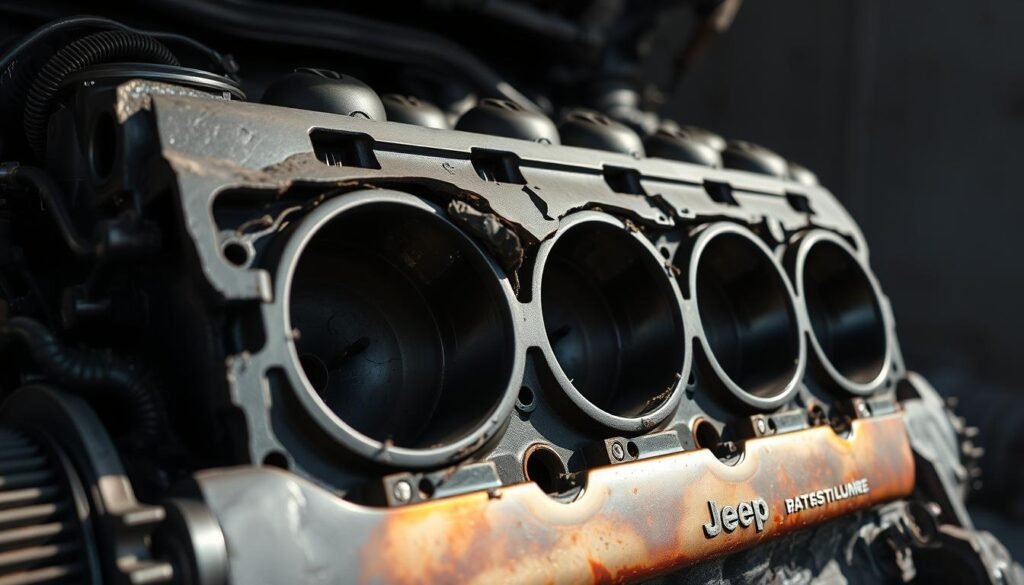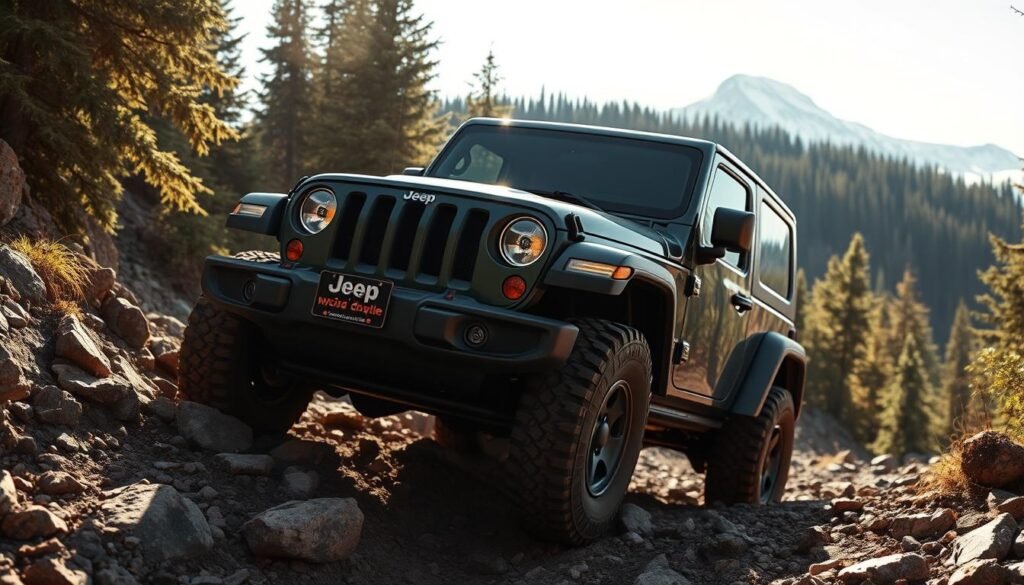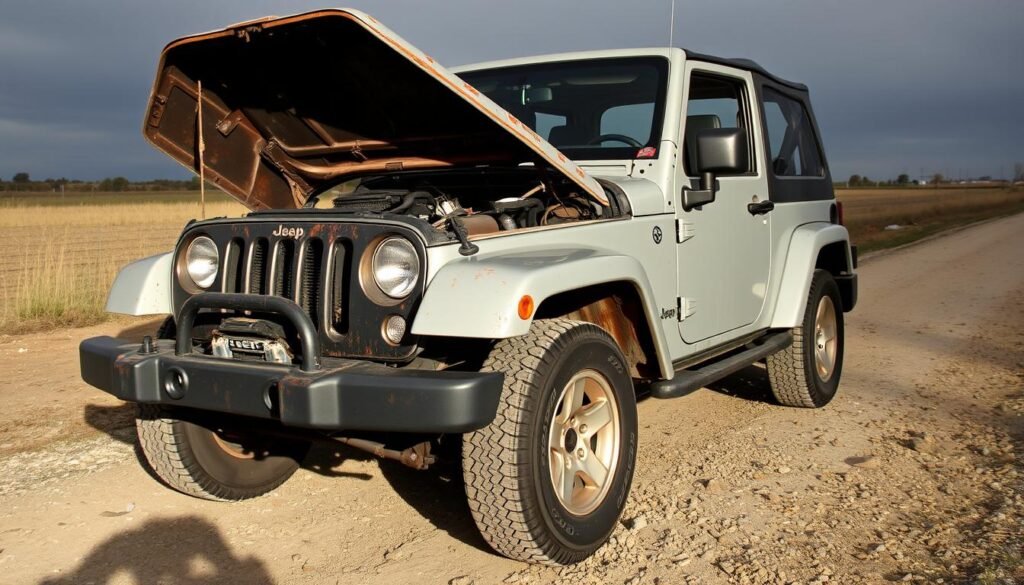Over 10 million Jeep vehicles have faced issues with the Pentastar V6 engine. Owners have reported big performance problems that can cost a lot to fix. The Jeep 3.6 engine troubles are a big worry for many car owners in the U.S.
The Pentastar V6 engine has been made for over 10 years. It has shown great power but also some reliability issues. Jeep Wrangler, Dodge Challenger, and Chrysler Pacifica owners have seen engine problems that need careful fixing.
Common Jeep 3.6 engine issues include overheating, often happening around 77,000 miles. Engine temperatures can hit a dangerous 250°F. Cylinder head failures, mainly in 2011-2013 models, are a big mechanical risk. These can cost up to $3,000 to fix.
It’s important to know about these Pentastar V6 engine problems to keep your car running well. This guide will cover the most common issues, how to diagnose them, and how to prevent them. It aims to help Jeep owners keep their cars in good shape.
The Pentastar V6 Engine Architecture
The Pentastar V6 engine is a major leap in Jeep engine design. It shows off advanced engineering and top-notch performance. Chrysler created this engine, which has become key for many vehicles starting in 2011.
Engine Specifications and Design Features
The Pentastar V6 engine stands out with its impressive specs. Here are some key details:
- Displacement: 3.6 liters
- Horsepower: 285 hp
- Torque: 260 lb-ft
- Compression ratio: 10.2:1
- Weight: 94 pounds lighter than the old 3.7-liter engine
Manufacturing History and Vehicle Applications
Chrysler worked hard to make the Pentastar V6 engine perfect. They spent over 45,000 hours on computer simulations. The engine was tested a lot, logging millions of miles.
This engine powers many vehicles, including:
- Jeep Wrangler
- Jeep Grand Cherokee
- Chrysler 300
- Dodge Challenger
- Ram trucks
Performance Capabilities and Limitations
The engine’s performance is impressive:
- Acceleration: 0-60 mph in 6.1 to 7.5 seconds
- 90% of peak torque available between 1,800 and 6,350 rpm
- Typical engine lifespan: 200,000 to 400,000 miles with proper maintenance
Despite its strengths, the Pentastar V6 has some limits. Its reliability has gotten better over time. Recent models (2018-2024) have an 8.5/10 reliability score, up from 6/10 for earlier models.
Most Common Jeep 3.6 Engine Problems
Jeep owners with the 3.6L Pentastar V6 engine face several major issues. These problems can hurt your car’s performance and reliability. Knowing about these issues is key to keeping your Jeep running well.
The most common engine problems include:
- Cylinder Head Failures: A serious issue that can cause misfires and lower performance
- Rocker Arm Malfunctions: Often show up as odd ticking sounds
- Cooling System Complications: Can lead to dangerous overheating
- Debris Accumulation: Affects how well engine parts work
Cylinder head failures are a big worry, like in Jeep Wranglers. They can turn on the check engine light and hurt engine performance. Rocker arm problems, with their unique ticking sounds, need a detailed check.
The cooling system is another area of concern. Overheating can happen for many reasons, like a bad water pump or radiator issues. It’s important to watch coolant levels and fix any temperature problems fast.
Regular maintenance and catching problems early are important. By doing regular checks, changing oil on time, and fixing small issues, you can make your Jeep’s 3.6L Pentastar engine last longer.
Engine Start Issues and Misfire Concerns
Jeep owners with the 3.6L Pentastar engine often face tough starting problems. These issues can really upset even the most patient drivers. They can affect your vehicle’s performance and reliability.
Common Symptoms of Starting Problems
It’s important to spot early signs of 3.6L Pentastar misfires to avoid engine damage. Drivers might notice:
- Prolonged cranking before engine start
- Intermittent “Stop/Start unavailable” warning messages
- Check engine light illumination
- Rough idling or engine stuttering
- Diagnostic trouble codes like P0305 (cylinder misfire)
Diagnostic Approaches and Solutions
To tackle Jeep engine starting problems, a systematic approach is needed. Mechanics suggest:
- Using OBD-II scanners to read diagnostic codes
- Inspecting spark plugs for wear or damage
- Checking ignition coils and fuel system components
- Verifying battery and alternator performance
*”Over ten million Chrysler, Dodge, and Jeep vehicles have utilized the 3.6L Pentastar V6 Engine,”* showing its widespread use and common issues.
Prevention and Maintenance Tips
Preventive maintenance can lower the chance of 3.6L Pentastar misfires. Try these tips:
- Regular spark plug inspections and replacements
- Use premium gasoline when possible
- Perform consistent oil changes
- Address diagnostic codes immediately
- Schedule routine professional engine diagnostics
Early detection and quick action are vital for keeping your Jeep’s engine in top shape and avoiding expensive repairs.
Engine Ticking Sound: Causes and Solutions
The Jeep 3.6 engine noise, known as the Pentastar ticking sound, worries many Jeep owners. This constant tick can cause big worries and even mechanical problems.
Many owners hear a distinct ticking sound that gets louder as the engine speeds up. The main reasons for this ticking sound are:
- Rocker arm (cam follower) failures
- Oil circulation problems in the valvetrain
- Incorrect air filter installations
- Failing oil pump mechanisms
The main cause of the ticking sound is often needle bearing wear in roller rockers. This design flaw can cause serious engine damage if not fixed.
| Repair Aspect | Estimated Cost |
|---|---|
| Replacement Rockers | $10 per rocker |
| Camshaft Replacement | $350+ per camshaft |
| Total Repair Costs | $1,500 – $2,000 |
To fix the Pentastar ticking sound, you should:
- Do a full engine check
- Look at oil flow and quality
- Check rocker arms and camshaft parts
- Think about getting a pro to test it
Keeping your engine in good shape can prevent big problems. Regular oil changes, using good engine oil, and catching early signs are key for engine health.
Spotting and fixing problems early can save a lot of money on repairs.
Overheating Issues in the 3.6L Engine
The Jeep 3.6 Pentastar engine faces cooling system challenges. This can cause serious overheating problems. Engine temperatures can reach up to 240-260 degrees Fahrenheit, posing risks to performance and longevity.
Critical Cooling System Components
It’s important to know the Jeep 3.6 engine’s cooling system. This includes several key parts that help manage temperature:
- Radiator
- Water pump
- Thermostat
- Coolant hoses
- Cooling fans
Temperature Management Solutions
To fix Jeep 3.6 engine overheating, several steps are needed. The thermostat is key, opening at about 221 degrees Fahrenheit. This is higher than most engines.
| Component | Average Replacement Cost | Potential Impact |
|---|---|---|
| Water Pump | $173.00 | Critical for coolant circulation |
| Thermostat | $39.92 | Regulates engine temperature |
| Radiator | $90.00 | Dissipates heat from coolant |
Prevention Strategies
To avoid Pentastar cooling system problems, regular maintenance is key:
- Perform regular coolant flushes
- Inspect cooling system components frequently
- Monitor coolant levels
- Check for possible leaks
- Use high-quality coolant
By staying alert, owners can reduce the risk of Jeep 3.6 engine overheating. Understanding these system dynamics and maintaining the vehicle well are essential.
Cylinder Head Failures and Related Problems

Cylinder head failures are a big worry for Jeep 3.6 Pentastar engine owners. These problems can hurt how well your car runs and might even cause serious engine damage. Automotive experts have found specific issues with Jeep 3.6 cylinder heads that owners need to know about.
The left side cylinder head failure is a big problem, happening in about 0.5% of 2011-2013 cars with the Pentastar V6 engine. Chrysler fixed this issue in August 2012. This change greatly cut down on the number of failures.
- Common signs of Jeep 3.6 cylinder head problems include:
- Ticking sounds from the engine
- Illuminated check engine light
- Cylinder misfires
- Noticeable power loss
Chrysler has a special warranty for the left side cylinder head. It covers 2011, 2012, and some 2013 models for 10 years or 150,000 miles. This warranty is a big help for owners worried about cylinder head failures.
| Issue | Frequency | Warranty Coverage |
|---|---|---|
| Left Side Cylinder Head Failure | 0.5% of 2011-2013 vehicles | 10 years/150,000 miles |
| Design Upgrade Implementation | August 2012 | Reduced failure rates |
Regular maintenance is key to avoiding Pentastar engine failures. Owners should watch for early signs and get their cars checked often. Acting quickly can stop bigger and more expensive engine problems.
Oil System Complications and Maintenance
The Jeep 3.6 Pentastar engine’s oil system needs careful attention to avoid big problems. Jeep Wrangler owners must know how to maintain it well to keep the engine running smoothly for a long time.
It’s important to understand the oil system of the Pentastar engine. Knowing the possible issues that can happen if you don’t take care of it is key. The oil filter housing and cooler assembly are two main areas to watch out for.
Oil Pressure Issues
Oil pressure problems can show up in different ways:
- Engine tapping or knocking sounds
- Illuminated oil pressure warning light
- Erratic oil pressure gauge readings
- Potential engine performance reduction
The Pentastar engine’s oil pressure should be between 10 and 80 PSI. Any changes from this range mean you need to check the engine.
Recommended Oil Types and Change Intervals
| Oil Type | Recommended Interval | Performance Rating |
|---|---|---|
| Synthetic Blend | 5,000-7,500 miles | Good |
| Full Synthetic | 7,500-10,000 miles | Excellent |
| Conventional | 3,000-5,000 miles | Standard |
Experts say it’s best to fix oil system problems early. The Dorman aftermarket oil filter housing is made of aluminum. It’s stronger than the original plastic one.
Ignoring the Jeep 3.6 oil system can cost a lot. Replacing parts like the oil filter housing can cost between $125 and $800. Regular checks and maintenance are key to avoiding big engine problems.
Cooling System Design Flaws and Solutions

Jeep owners with the 3.6 Pentastar engine often face cooling system problems. These issues can hurt engine performance. The cooling system’s design has weak points that may cause overheating and failures.
Key areas to focus on for solving overheating issues include:
- Plastic radiator parts that can break down
- Water pump reliability issues
- Possible coolant flow problems
- Weaknesses in temperature control
The JK Freaks community has shared many cases of plastic cooling system failures. These problems can harm engine life and lead to costly fixes if not fixed early.
| Cooling System Component | Potential Issues | Recommended Action |
|---|---|---|
| Radiator | Plastic deterioration | Consider aftermarket aluminum replacements |
| Water Pump | Premature wear | Regular inspection and early replacement |
| Coolant Passages | Potential blockage | Periodic system flush and maintenance |
Proactive maintenance is key to avoiding cooling system problems. Jeep owners should check their systems regularly. They should also think about replacing key parts to avoid failures.
Technical service bulletins and recalls from the manufacturer offer help. They guide owners in fixing the 3.6 Pentastar engine cooling system’s design flaws.
Preventive Maintenance Guidelines for Jeep 3.6 Engine Longevity
Keeping your Jeep 3.6 engine in top shape is key to its long life. Regular oil changes are essential. Change the oil every 5,000 miles with synthetic oil to protect your engine.
For a long-lasting Pentastar V6, take care of your vehicle. Check the cooling system often and replace coolant as needed. Also, don’t forget to check the transmission fluid, air filters, and radiator.
Regular checks can help find problems before they get worse. Look out for odd noises, temperature changes, or if your car uses more gas than usual. Have a mechanic check your car at least twice a year.
Choose the best parts and stick to the maintenance schedule. Using ACDelco or OEM parts and keeping the radiator clean helps a lot. Fixing small problems early saves you from big repairs later.
FAQ
What are the most common problems with the Jeep 3.6 Pentastar V6 engine?
Common issues include cylinder head failures and rocker arm problems. You might also hear engine ticking sounds. Other problems include cooling system malfunctions and oil pressure issues. These can cause misfires, performance loss, overheating, and unusual noises.
How serious are the cylinder head failures in the Jeep 3.6 engine?
Cylinder head failures are serious and can damage the engine. Symptoms include losing power, using more oil, and coolant leaks. In severe cases, you might need to replace the cylinder head or overhaul the engine.
Why does my Jeep 3.6 engine make a ticking noise?
Ticking sounds often come from rocker arm failures or oil issues. This can be due to not enough oil, wear, or defects. It’s important to fix this quickly to avoid engine damage.
How can I prevent major issues with my Jeep 3.6 engine?
Regular maintenance is essential. Stick to the recommended service schedule and use quality oils and parts. Regular inspections and addressing small problems early are also key. Make sure to use the right coolant and oil for your Jeep.
What causes overheating in the Jeep 3.6 engine?
Overheating can be caused by many things. This includes a faulty radiator, water pump problems, or thermostat failures. Regular maintenance and the right coolant can help avoid these issues.
Are there any known manufacturing defects in the Jeep 3.6 Pentastar engine?
Yes, early models have had issues. These include problems with the cylinder head, oil system, and cooling system. Jeep has fixed some of these with service bulletins and warranty extensions.
How long can a well-maintained Jeep 3.6 engine last?
A well-maintained engine can last 150,000 to 200,000 miles. Regular oil changes and addressing issues quickly are key. Following the manufacturer’s maintenance guidelines also helps.
What should I do if I notice early signs of engine problems?
If you notice unusual noises, performance loss, or warning lights, get it checked. A professional mechanic who specializes in Jeep vehicles can help. Early diagnosis can save you from expensive repairs later.


